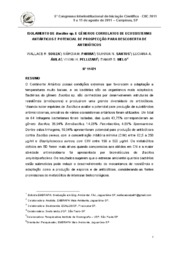Isolamento de Bacillus sp. e gêneros correlatos de ecossistemas antárticos e potencial de prospecção para descoberta de antibióticos.
Isolamento de Bacillus sp. e gêneros correlatos de ecossistemas antárticos e potencial de prospecção para descoberta de antibióticos.
Author(s): SOUZA, W. R.; PARMA, M. M.; SANTOS, S. N.; AVILA, L. A.; PELLIZARI, V. H.; MELO, I. S. de
Summary: Resumo: O Continente Antártico possui condições extremas que favorecem a adaptação a temperaturas muito baixas, e as bactérias são os organismos mais adaptados. Bactérias do gênero Bacillus sp. são conhecidas por desenvolverem estruturas de resistência (endósporos) e produzirem uma grande diversidade de antibióticos. Visando isolar espécies de Bacillus e avaliar o potencial para produção de substâncias antimicrobianas, amostras de vários ecossistemas antárticos foram utilizados. Um total de 64 linhagens bacterianas foram isoladas, das quais 43,75% corresponderam ao gênero Bacillus, 35,94% Brevibacillus, 14,06% Paenibacillus, 4,69% Sporosarcina. Dentre estas linhagens, 10,94% apresentaram potencial para produção de antibióticos contra Bacillus cereus, com a concentração inibitória mínima (CIM) entre 62,5 a 250 microg/ml e Staphylococcus aureus, com CIM entre 150 a 500 microg/ml. Os metabólitos obtidos em BD foram mais ativos quando comparados aos obtidos em CN e a maior atividade antimicrobiana foi apresentada por biomoléculas de Bacillus amyloliquefaciens. Os resultados sugerem que o estresse ambiental que tais bactérias estão submetidas pode induzir o desenvolvimento de mecanismos de resistência e adaptação como a produção de esporos e de antibióticos, considerando-as fontes promissoras de metabólitos de interesse biotecnológicos. Abstract: The Antarctic continent with extreme conditions, present conditions for adaptations to very low temperature, and the bacteria are the organisms more adapted. Bacteria belonging to Bacillus sp. are known to develop resistance structures (endospores) as well as produce a wide variety of antibiotics. In order to isolate Bacillus sp. and assess their potential for antimicrobial substances production, samples from several Antarctic ecosystems were used. A total of 64 bacterial strains were isolated, of which 43.75% corresponded to the genus Bacillus, 35,94% Brevibacillus, 14,06% Paenibacillus and 4,69% Sporosarcina. Among these strains, 10.94% showed potential for the production of antibiotics against Bacillus cereus, with minimum inhibitory concentration (MIC) between 62,5 to 250 ?g/ml and Staphylococcus aureus, with MIC between 150 to 500 ?g/ml. The metabolites obtained from BD were more active when compared to those obtained in BD and the highest antimicrobial activity was presented by biomolecules from Bacillus amyloliquefaciens. The results suggest that the environmental stress that these bacteria are subjected to can induce the development of resistance mechanisms and adaptation as the production of spores and antibiotics, considering them as promising sources of biotechnological interest metabolites.
Publication year: 2011
Types of publication: Paper in annals and proceedings
Unit: Embrapa Environment
Keywords: Antibiótico, Bacilo
Observation
Some of Embrapa's publications are published as ePub files. To read them, use or download one of the following free software options to your computer or mobile device. Android: Google Play Books; IOS: iBooks; Windows and Linux: Calibre.
Access other publications
Access the Agricultural Research Database (BDPA) to consult Embrapa's full library collection and records.
Visit Embrapa Bookstore to purchase books and other publications sold by Embrapa.

